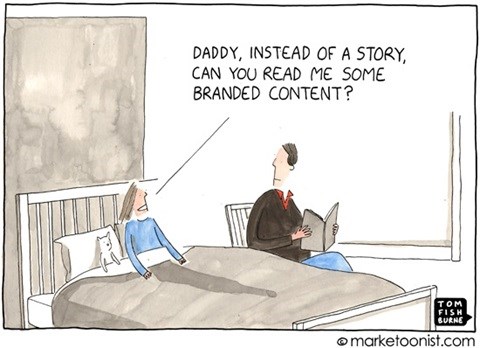Spinning branded content
Since advertising agencies discovered content, storytelling has become an overused buzzword and the real meaning of storytelling is often lost in the telling. I think it is a great antidote to the bad 30-second TVC, but good advertising has always told stories, always engaged consumers by touching their emotions - which is what great stories do.
What digital development has allowed us to do is take those stories further, onto other mediums, to draw consumers in, to involve them in the story.
The bedtime story analogy comes from Shiftcomm.com in a post entitled 'The bedtime test of content marketing and PR'. Christopher Penn, vice president of Marketing Technology, writes on Shiftcomm.com that the "acid test" for compelling content is to offer to read a white paper or a press release to a child at bedtime to see if you can engage their attention for longer than a minute.

He cites as a good example, that of Marketo Corporation which released a colouring book to illustrate B2B marketing. This is clever, but a bit simplistic, not all customers want to be engaged like a five or a 10-year-old, but the point is important: know what is important to your customers so that you know what to engage them on.
Formulaic
It is easy to write a press release, there's a formula. It is far harder to write a story that someone wants to read - although there is also a formula to writing great stories which is why creative writing groups are stuffed with aspirant writers wanting to learn to write the great novel. Stories need to be engaging; they need to tell a real story, be authentic; they need passion; and they need to be about what your audience, as a brand, cares about.
I like how writer Gini Dietrich, the CEO of Arment Dietrich, an integrated marketing communications firm, breaks it down on Spinsucks.com: stories, brand storytelling included, need to have "a protagonist, an antagonist, a revelation, and the transformation".
This is her example and a very good one: "Mailchimp tells their customers stories in interesting ways. They don't have their customers talk about how they use MailChimp. They have them talk about their restaurant or their fashion design company or their business cartoons. These aren't customer quotes or testimonials; these are customer stories. The passion lies in how your product is created, your office culture, the one thing your organisation truly cares about that makes you unique and valuable to the world around you."
Dietrich contends that brand storytelling, content marketing, call it what you will, is overhyped because organisations are not doing it well. She breaks it down as follows, in brief:
- 1. Passion - find out what your audience really cares about as that is how you will get their attention.
2. The Protagonist - that is you, your company, your product/service. Find the rockstar in your organisation.
3. The Antagonist - this is the enemy of your success, the things your customers worry about, a problem or issue you need to solve.
4. The Revelation - something unexpected that surprises and delights your customers, or is poignant and touches their hearts.
Ogilvy & Mather Cape Town said in its press release on the appointment of digital marketer Melissa Attree as new Director of Content Strategy, that it highlighted the importance of providing the best solutions for their clients, that they were willing to create positions for the best talent out there and to meet the needs of their clients.
Managing director of O&M CT, Luca Gallarelli, said the appointment was "another important pioneering step by O&M towards delivering the really integrated, flexible and multi-platform work that clients should expect - her role will be to create and connect strategies to smart, tangible outcomes in whatever form they can be best executed".
This is a significant appointment for a mainstream advertising agency in South Africa and ups the ante on the game being played out by everyone who is prioritising content: from the specialist media companies, to digital agencies, advertising agencies and public relations firms.
Content marketing and branded content might in fact be the most significant shift in marketing since branding agencies and brand science was established as a separate and important part of the marketing communications discipline 20 years ago.
Source: TRENDAFRiCA.co.za

TRENDAFRiCA is a trend watching portal on consumer insight, research and trends from South Africa and further afield on the continent of Africa. It includes DAiLY trends headlines from around the world, influential Trendspotter columnists and in-depth reports on industry segments. Louise Marsland is the founder and editor.
Go to: www.trendafrica.co.za





















